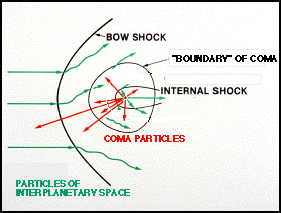This picture shows what happens when the molecules coming from the comet encounter interplanetary space.
Click on image for full size
JPL
The comet's interaction with interplanetary space, part 1
Why the magnetic field slows down to slip around the comet
When evaporation begins, the gas is propelled from the nucleus at supersonic speed (depicted by arrows in the figure). Because of the low gravity in space, this means that the molecules from the nucleus extend very far into space, and form a huge cloud around the nucleus. (Due to the scale of this picture, the nucleus is too small to be seen in this picture).
Interplanetary space is not empty, however, but contains dust, particles with an electric charge, and the magnetic field of the sun (also called the IMF, or Interplanetary Magnetic Field). The particles of interplanetary space also travel at supersonic speeds.
When the cloud of gas from the comet encounters the cloud of particles which fill interplanetary space, particles of the two clouds collide with each other and are forced to slow down to subsonic speeds. This process causes two shocks to form, a bow shock, the same sort of bow shock which exists as part of every planetary environment, and an internal shock which is unique to comets. Between these two shocks, the two clouds interact.
Because the particles slow down, the magnetic field must also slow down. The comet tail forms as the slowed magnetic field tries to slip around the coma of the comet.
You might also be interested in:
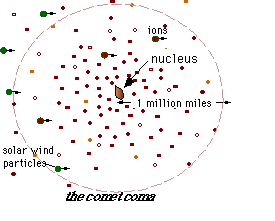
As the ices of the comet nucleus evaporate, they expand rapidly into a large cloud around the central part of the comet. This cloud, called the coma, is the atmosphere of the comet and can extend for millions
...more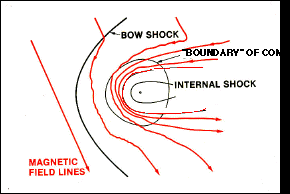
The magnetic field of the sun (the IMF) is distorted in passing over the comet, taking a long time to slip around the sizeable ion cloud which forms the comet coma. The stretched magnetic field lines form
...more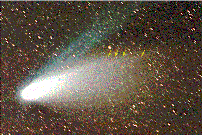
Hale-Bopp continues to offer new surprises as two astronomers report of their study of the comet. Using the Hubble Space Telescope and the International Ultraviolet Explorer, the astronomers did a year-long
...more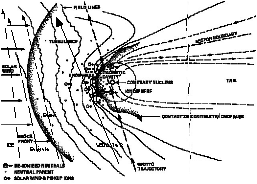
Six spacecraft flew by Halley's comet in 1986. There were two spacecraft launched from Japan, Suisei and Sakigake, and two from the Soviet Union, Vega 1 & 2. One spacecraft, ICE, from the United States
...more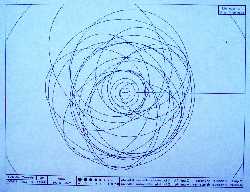
Comets are observed to go around the sun in a long period of time or a short period of time. Thus they are named "long-period" or "short-period" comets. One group of short-period comets, called the Jupiter
...more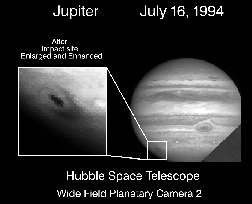
Scientists have learned a great deal from the crash of comet Shoemaker-Levy 9. Scientists traced the orbit of the comet backwards in time to guess its origin. The crash of a comet like Shoemaker-Levy 9
...more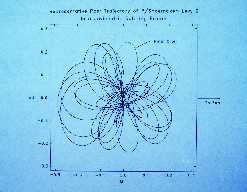
Mathematical theory suggests that comet Shoemaker-Levy 9 was likely a short-period comet which was captured into orbit around Jupiter in 1929 and began to execute the path plotted in this diagram. This
...more


